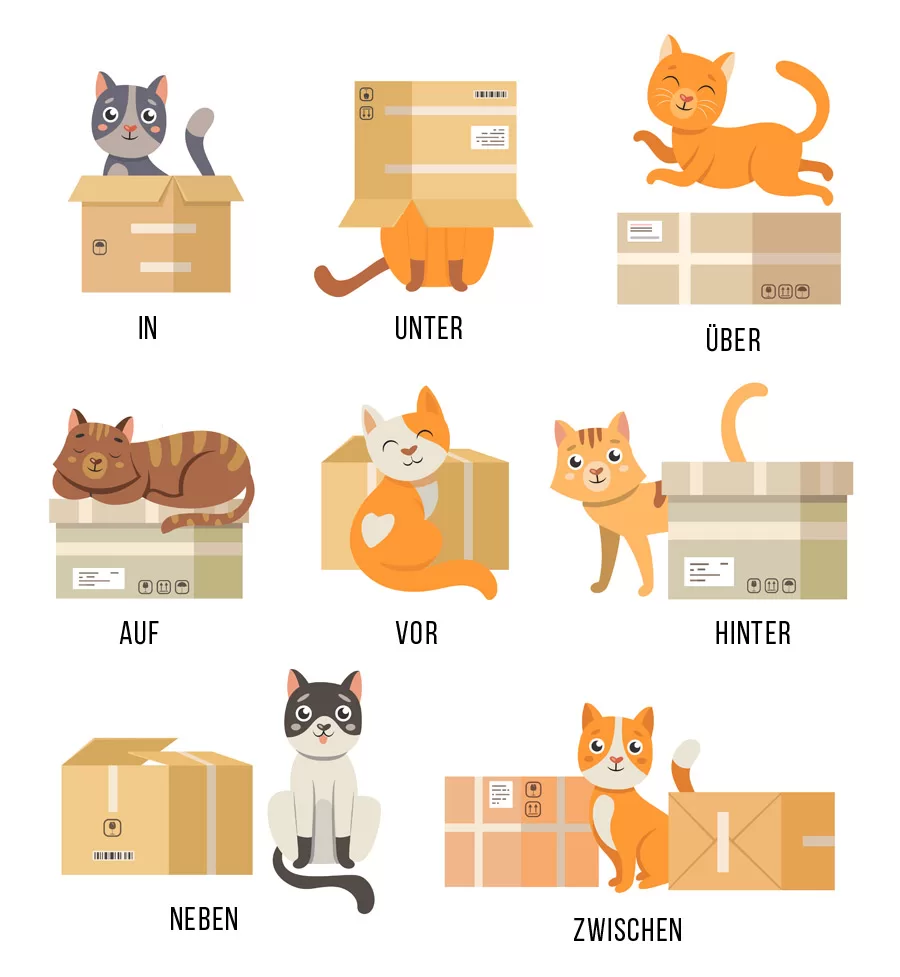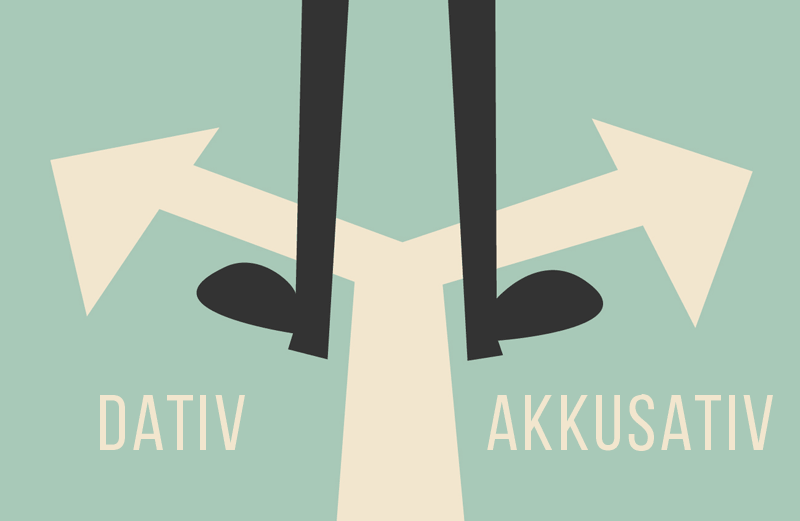
Introduction
Learning German can be challenging, especially when it comes to grammar topics like prepositions. These little words can change the meaning of a sentence drastically, and in my experience as a German teacher, after declension and word order it’s one of the main topics beginners are struggling with.
In this article, we will dive deep into the world of German prepositions, learning their types, their usage, and tips for mastering them. So let’s begin! (I’ve also included two interactive quizzes so you can check your understanding along the way.)
Types of Prepositions
German prepositions can be categorized into three main types. As with most German grammar topics we just use the Latin words:
- Lokale Präpositionen – Locative Prepositions
- Temporale Präpositionen – Temporal Prepositions
- Kausale Präpositionen – Causal Prepositions
Their basic meaning shouldn’t be too hard to infer from their names. Temporal Prepositions are used to express time, such as when an event occurs. Causal Prepositions indicate the cause or reason for an action, while Locative Prepositions help describe the location or position of an object or person.
Examples of German Prepositions
Let’s look at examples of each type of preposition to better understand their usage. We’ll start with the easiest ones:
Locative Prepositions Examples
- an (at, on): Das Bild hängt an der Wand. (The picture hangs on the wall.)
- auf (on, atop): Der Schlüssel liegt auf dem Tisch. (The key is on the table.)
- hinter (behind): Das Auto steht hinter dem Haus. (The car is parked behind the house.)
- in (in): Die Bücher sind in der Schublade. (The books are in the drawer.)
- neben (next to): Er sitzt neben seinem Freund. (He is sitting next to his friend.)
- über (above, over): Die Lampe hängt über dem Tisch. (The lamp hangs above the table.)
- unter (under): Der Hund liegt unter dem Bett. (The dog is lying under the bed.)
- vor (in front of): Die Kinder spielen vor dem Haus. (The children are playing in front of the house.)
- zwischen (between): Das Geschäft liegt zwischen zwei Straßen. (The store is located between two streets.)
These prepositions describe the position or location of objects or people in relation to one another. Keep in mind that some of these prepositions are two-way prepositions (one of my favorite topics) and can take either the dative or accusative case depending on the context. We’ll take a look at those further down.

Let’s do a quick exercise:
Next, let’s continue with prepositions that deal with time:
Temporal Prepositions Examples
- am (on)
Ich bin am Montag im Urlaub.
(I am on vacation on Monday.)
- um (at)
Das Meeting ist um 14 Uhr.
(The meeting is at 2 PM.)
- in (in)
Wir treffen uns in zwei Wochen.
(We’ll meet in two weeks.)
The similarities between German sometimes can make it tricky to choose the right preposition when talking about time.
Causal Prepositions Examples
Next, let’s take a look at preposition that relate to causes or reasons for doing something:
- dank + Gen. (thanks to):
Dank ihrer Hilfe haben wir den Fehler gefunden.
(Thanks to her help, we found the mistake.)
- trotz + Gen. (despite, in spite of):
Trotz seiner Müdigkeit arbeitete er weiter.
(Despite his tiredness he continued working.)
- aufgrund + Gen. (due to, on account of):
Das Konzert wurde aufgrund technischer Probleme abgesagt.
(The concert was canceled due to technical problems.)
- infolge + Gen. (as a result of, following):
Infolge des starken Schneefalls sind die Straßen unpassierbar.
(As a result of heavy snowfall, the roads are impassable.)
- wegen + Gen. (because of, on account of):
Wegen eines Unfalls ist die Autobahn gesperrt.
(The highway is closed because of an accident.)
These causal prepositions help establish cause-and-effect relationships, reasons, or explanations for various situations in German sentences. Remember that these prepositions (almost always) require the genitive case.
Dative and Accusative Prepositions
In German, some prepositions take the dative case, while others take the accusative case. For instance, aus (from) and bei (with) are dative prepositions, while durch (through) and für (for) are accusative prepositions. Make sure to learn which prepositions belong to each category to avoid grammatical errors.
Two-way Prepositions

Some prepositions are considered two-way because they can take either the dative or accusative case, depending on the context. They are also known as “Wechselpräpositionen” in German. Examples of two-way prepositions include an (at), auf (on), in (in), and unter (under). To determine which case to use, remember that if the action involves motion or a change of location, use the accusative; if it describes a static location, use the dative.
- an (at, on):
- Accusative (motion): Er hängt das Bild an die Wand. (He hangs the picture on the wall.)
- Dative (static): Das Bild hängt an der Wand. (The picture hangs on the wall.)
- auf (on, atop):
- Accusative (motion): Sie legt das Buch auf den Tisch. (She puts the book on the table.)
- Dative (static): Das Buch liegt auf dem Tisch. (The book is on the table.)
- hinter (behind):
- Accusative (motion): Er stellt das Auto hinter das Haus. (He parks the car behind the house.)
- Dative (static): Das Auto steht hinter dem Haus. (The car is parked behind the house.)
- in (in):
- Accusative (motion): Er stellt die Bücher in den Schrank. (He puts the books in the cupboard.)
- Dative (static): Die Bücher sind in dem Schrank. (The books are in the cupboard.)
- neben (next to):
- Accusative (motion): Er setzt sich neben seinen Freund. (He sits down next to his friend.)
- Dative (static): Er sitzt neben seinem Freund. (He is sitting next to his friend.)
- über (above, over):
- Accusative (motion): Sie hängt die Lampe über den Tisch. (She hangs the lamp above the table.)
- Dative (static): Die Lampe hängt über dem Tisch. (The lamp hangs above the table.)
- unter (under):
- Accusative (motion): Er legt das Buch unter den Tisch. (He puts the book under the table.)
- Dative (static): Das Buch liegt unter dem Tisch. (The book is under the table.)
- vor (in front of):
- Accusative (motion): Sie stellt das Fahrrad vor das Haus. (She puts the bike in front of the house.)
- Dative (static): Das Fahrrad steht vor dem Haus. (The bike is in front of the house.)
- zwischen (between):
- Accusative (motion): Sie stellt die Vase zwischen die Blumen. (She puts the vase between the flowers.)
- Dative (static): Die Vase steht zwischen den Blumen. (The vase is between the flowers.)
Prepositions with Verbs
Certain German verbs are always followed by specific prepositions. For example, sich freuen auf (to look forward to) or sich ärgern über (to be annoyed about). Learning these verb-preposition combinations is essential for speaking and understanding German correctly.
| German Verb | Preposition | Translation |
|---|---|---|
| achten | auf | to pay attention to |
| sich ärgern | über | to be annoyed about |
| sich beschweren | über | to complain about |
| sich bewerben | um | to apply for |
| bitten | um | to ask for |
| denken | an | to think about |
| sich erinnern | an | to remember |
| sich freuen | auf | to look forward to |
| sich interessieren | für | to be interested in |
| sich konzentrieren | auf | to concentrate on |
| sich kümmern | um | to take care of |
| lachen | über | to laugh about |
| sprechen | über | to talk about |
| sich verlassen | auf | to rely on |
| warten | auf | to wait for |
Common German Preposition Pairings
Some prepositions are often used together, like anstatt (instead of), außerhalb (outside of), or innerhalb (inside of). These pairings help express relationships between objects and actions (or in time).
- anstatt + Gen. (instead of):
- Anstatt eines Buches kaufte er eine Zeitschrift. (Instead of a book, he bought a magazine.)
- außerhalb + Gen. (outside of):
- Die Fabrik liegt außerhalb der Stadt. (The factory is located outside of the city.)
- innerhalb + Gen. (within, inside of):
- Innerhalb weniger Stunden war das Essen fertig. (The meal was ready within a few hours.)
Prepositions in Fixed Expressions
Some German expressions have fixed prepositions that cannot be replaced or omitted. Examples include auf Wiedersehen (goodbye), vor kurzem (recently), and zum Glück (fortunately). Familiarizing yourself with these expressions will improve your overall language skills.
- auf jeden Fall (in any case, definitely): Wir gehen auf jeden Fall ins Kino. (We are definitely going to the cinema.)
- im Allgemeinen (in general): Im Allgemeinen ist das Wetter gut. (In general, the weather is good.)
- unter anderem (among other things): Er spricht unter anderem Englisch und Spanisch. (He speaks English and Spanish, among other languages.)
- von Zeit zu Zeit (from time to time): Von Zeit zu Zeit gehe ich ins Fitnessstudio. (From time to time, I go to the gym.)
- außerhalb von (outside of): Sie wohnt außerhalb von Berlin. (She lives outside of Berlin.)
- innerhalb von (within, inside of): Er kommt innerhalb von einer Stunde. (He will arrive within an hour.)
These fixed expressions are often used in everyday German conversation and writing. It’s essential to memorize them as a whole, as they typically cannot be translated word-for-word into English.
Contractions with German Prepositions
In some instances, prepositions combine with definite articles to form contractions. For example, bei + dem becomes beim and zu + der becomes zur. Using contractions can help your German sound more natural and fluent.
- an + dem = am: Ich warte am Bahnhof. (I’m waiting at the train station.)
- bei + dem = beim: Er arbeitet beim Arzt. (He works at the doctor’s office.)
- in + dem = im: Wir sind im Kino. (We are in the cinema.)
- von + dem = vom: Das Geschenk ist vom Chef. (The gift is from the boss.)
- zu + dem = zum: Ich gehe zum Supermarkt. (I’m going to the supermarket.)
- zu + der = zur: Sie fährt zur Schule. (She’s going to school.)
- auf + dem = aufm: Das Buch liegt aufm Tisch. (The book is on the table.) Note: This contraction is colloquial and not commonly used in formal writing.
These contractions are used frequently in everyday German and can make your speech sound more natural. However, keep in mind that some contractions, like “aufm,” are considered colloquial and should be avoided in formal writing.
Tips for Learning German Prepositions
- Practice using prepositions in context by creating sentences or engaging in conversation.
- Use flashcards to memorize prepositions and their corresponding cases.
- Study verb-preposition combinations to enhance your understanding of German grammar.
- Familiarize yourself with fixed expressions and common preposition pairings.
- Download free German worksheets to further practice prepositions.
Conclusion
y understanding the different types of prepositions, their usage, and the various cases they take, you can improve your German grammar and communication skills. Remember to practice using prepositions in context and familiarize yourself with common expressions and verb-preposition combinations to enhance your overall language abilities.
FAQs
- What are the three main types of German prepositions? Temporal, causal, and locative prepositions are the three main types of German prepositions.
- What are two-way prepositions? Two-way prepositions can take either the dative or accusative case, depending on the context.
- How do I know whether to use the dative or accusative case with a two-way preposition? Use the accusative case when describing motion or change of location and the dative case for static locations.
- Why is it important to learn verb-preposition combinations? Certain German verbs are always followed by specific prepositions, so learning these combinations is essential for speaking and understanding the language correctly.
- What are some tips for learning German prepositions? Practice using prepositions in context, use flashcards, study verb-preposition combinations, and familiarize yourself with fixed expressions and common preposition pairings. Download worksheets for practice!
–
Test Your Knowledge



